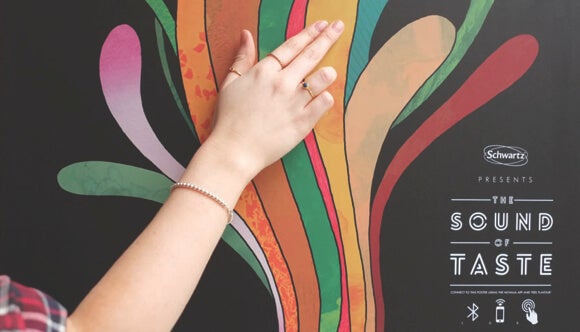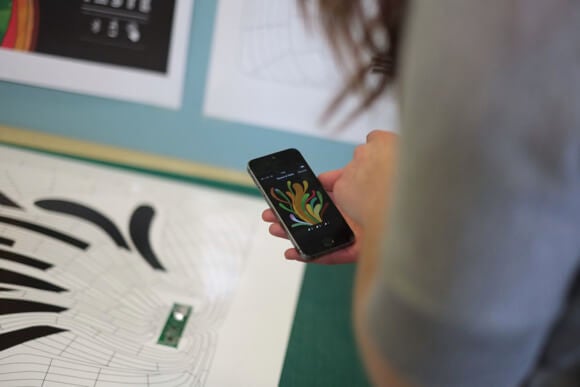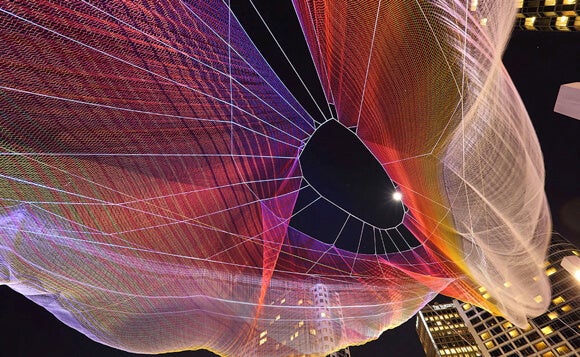You Can Hear the Taste of Spices by Touching This Poster

Share
If you have synesthesia, where one sensory input involuntarily stimulates another, the world is a symphony of color and a painting of sound. Taken from the Greek words "syn" (together) and "aisthesis" (perception), folks with synesthesia report one sense triggering another in a variety of combinations—they can hear color or smells, for example.
Though it's hard to pin an accurate number on how many people have synesthesia—many may have it and not know what it is—it's thought the ability is rare. Art, however, has long mixed sensory inputs, and a new sonic poster called “The Sound of Taste” uses technology to bring the synesthetic experience to the rest of us muggles.
In the making of “The Sound of Taste," Billie Jean, a conceptual illustrator, took 16 herbs and spices and gave each a suitable color, flowing biomorphic shape, and tone. Cumin, for example, is E flat major; chile is A flat major; fennel is F minor.
Ink technologist, Maria Menicou, then printed the poster using conductive ink from Novalia. The ink is touch sensitive. When connected to a smartphone, a different piano chord plays as each shape is touched.
“We’ve kind of hacked paper,” Menicou says. “We’re trying to find a way to get the interactivity back into print, so it works hand in hand with the digital world.” The poster was produced with ad agency, Grey London, for spice brand, Schwartz's.
The conductive ink itself detects touch much like a touchscreen on a smartphone might. The surfaces are wired to a central chip embedded in the paper and sent to nearby devices using Bluetooth. Collaborators need only download and open an app, which uses the device's speaker to play each chord when the poster is touched.
Be Part of the Future
Sign up to receive top stories about groundbreaking technologies and visionary thinkers from SingularityHub.


Digitally combining sensory experiences isn't new. Laser shows and concerts combine music, light, and color. And of course, iTunes has long had a "visualizer" that makes a computerized light show of anything in your library.
Many artists have either been synesthetes or been inspired to reproduce the experience. Artist Neil Harbisson was born color blind, but he now wears an electronic eye (or "eyeborg") that records the world and plays him sounds for the colors it sees. Now Harbisson hears color, making him, perhaps, the first cyborg synesthete.
In another recent example called Unnumbered Sparks (below), public artist Janet Echelman and Google’s head of data arts Aaron Koblin strung up a 745-foot web in Vancouver Canada. Participants controlled lights with their mobile devices to "paint" the canvas in real time, resulting in a beautifully collaborative, emergent piece of artwork.
These examples (and no doubt many more) show the increasingly blurred lines between the material and digital worlds and the power of technology beyond the purely practical.
Image Credit: Novalia, Unnumbered Sparks
Jason is editorial director at SingularityHub. He researched and wrote about finance and economics before moving on to science and technology. He's curious about pretty much everything, but especially loves learning about and sharing big ideas and advances in artificial intelligence, computing, robotics, biotech, neuroscience, and space.
Related Articles

This Light-Powered AI Chip Is 100x Faster Than a Top Nvidia GPU

How Scientists Are Growing Computers From Human Brain Cells—and Why They Want to Keep Doing It

These Brain Implants Are Smaller Than Cells and Can Be Injected Into Veins
What we’re reading




